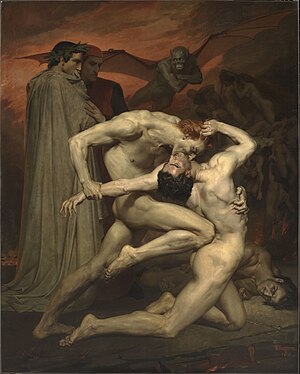The Divine Comedy is an Italian narrative poem by Dante Alighieri, begun around 1308 and completed in around 1321, shortly before the author's death. The poem's imaginative vision of the afterlife is representative of the medieval worldview as it existed in the Western Church by the 14th century. It helped establish the Tuscan dialect, in which it is written, as the standardized Italian language. It is divided into three parts: Inferno, Purgatorio and Paradiso. The subject of the narrative is the state of the soul after death and presents an image of divine justice meted out as due punishment or reward. In the poem, Dante travels through Hell, Purgatory and Heaven, and is accompanied by three guides: the Roman poet Virgil (who accompanies him for all of Hell and most of Purgatory), Dante's muse Beatrice (at the end of Purgatory and for most of Heaven) and Saint Bernard of Clairvaux (who guides him in the final cantos of Heaven).
This oil-on-canvas painting, titled Dante and Virgil and completed by the French artist William-Adolphe Bouguereau in 1850, depicts Dante with Virgil observing two damned souls in eternal combat in Hell. Capocchio, an alchemist and heretic, is being bitten on the neck by the trickster Gianni Schicchi, who had used fraud to claim another man's inheritance. The painting now hangs in the Musée d'Orsay in Paris.Painting credit: William-Adolphe Bouguereau
